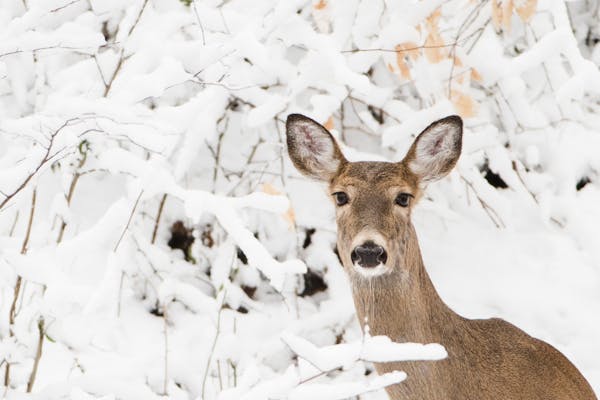Surprise findings of chronic wasting disease (CWD) in two wild deer this fall dimmed several bright spots in Minnesota's ongoing fight against a scourge that has the potential to spoil the state's most treasured hunting tradition.
Early last month along the North Dakota border, an experienced hunting family voluntarily tested a deer harvested southwest of Climax, Minn. When the sample came back as positive for CWD, the Department of Natural Resources scrambled to alert area hunters of an all-new battleground.
Four weeks later, just when it looked like a CWD management zone encompassing the Brainerd lakes area would be cleared of disease concerns, CWD showed up in a young buck harvested by a hunter near Nisswa.
Unfortunately for Brainerd area hunters and the DNR itself, the finding triggered at least three more years of testing mandates and other scripted measures, including carcass movement restrictions and extra hunting to thin deer populations.
DNR Wildlife Health Program Supervisor Michelle Carstensen said this week in an interview that the two cases are the latest examples of how the fatal neurological disease keeps smoldering but isn't close to putting a grip on the state's vast herd of whitetails.
"None of this means that all is lost, but we still have work to do,'' Carstensen said. "We have to stay diligent, look for sparks and stop the disease from catching fire.''
For instance, DNR biologists are anxious to ramp up CWD surveillance along the Red River Valley corridor around Climax. Was the incidental finding of the disease last month the tip of the iceberg in that area? Or was it a case of a deer wandering in from another unknown, infected area?
Working on short notice in that area, DNR received tissue samples from only about 65 hunters last month during the main firearms season. North Dakota officials also collected a modest number of tissue samples with no additional cases being reported.
To deepen the surveillance on the Minnesota side, a pair of deer permit areas stretching north from Moorhead to Oslo were hastily added to upcoming special hunting seasons allowed by the DNR in areas where CWD has been detected. DNR sells licenses for the weekend hunts at rock-bottom prices, but CWD testing of all deer is mandatory for hunters who have success. Those three-day hunts start Dec. 17 and Dec. 31.
Hot corner
Southeastern Minnesota continues to be Minnesota's CWD hotspot. In a briefing, Carstensen gave this week to members of the state House Environment and Natural Resources Finance and Policy Committee, she said tissue sampling of hunter-harvested deer in the Driftless Area this fall discovered 21 new cases of CWD and six more suspected. The area encompasses all of southeastern Minnesota below the line from Rochester to Winona.
Carstensen said the rate of new cases was in line with last year and the detections were on familiar turf where two clusters have formed: One around Preston and the other south of Winona, east of Rushford and north of La Crescent. At least one case close to Winona was linked years ago by the DNR to a now-defunct CWD-infected deer farm that had a history of whitetails escaping captivity.
Carstensen said seven of this year's new cases in the southeast were in the Winona-Rushford-La Crescent area, now known as Deer Permit Area 646. The positive results were returned from tissue samples submitted from 1,054 hunter-harvested deer. In the Preston area, a mix of mandatory and voluntary CWD testing detected the disease in nine deer throughout the hunting season.
She said surveillance in the southeast continues to show CWD persisting, but at a low rate – with less than 1% of submitted samples testing positive. Statewide since 2010, DNR has detected CWD in 136 wild deer.
"It's still rare but the fact that it's persisting is what's discouraging,'' Carstensen said "We can't get ahead of it.''
Watching for sparks
Liberalized bag limits are one of DNR's counter-measures against CWD, and hunters in the relatively new disease management zone that encompasses Dakota County could each harvest five deer this fall. Coupled with mandatory tissue sampling on opening weekend of the firearms season, the DNR detected two new cases. One added to a cluster of infection near Chub Lake, east of Elko New Market. The second case deviated from the cluster by about 10 miles.
Carstensen said her team hasn't found a probable cause for the outbreak in the south metro area.
In three other surveillance areas north of the Twin Cities, Carstensen said the news this fall was good: No findings of CWD.
One site is around a Pine County deer farm and a second site is around a Douglas County deer farm. CWD was detected in deer at both places as part of an investigation announced in April 2020. Carstensen said sampling of hunter-harvested deer was low in 2020 because of the coronavirus pandemic but rebounded well this year. If one more year goes by without finding the disease, CWD management in those areas could be dropped.
"It's the second year and both those areas are looking good,'' Carstensen said.
New to the scene in 2021 was a large area north, south, east and west of a CWD-infected Beltrami County deer farm where an investigation revealed illegal dumping of the farm's deer remains on public land. State taxpayers paid to fence the dump site and University of Minnesota researchers proved that it was contaminated by infectious prions.
Carstensen said she'll be meeting soon with Beltrami area tribal officials who, like the DNR, gathered tissue samples from wild deer harvested this fall by hunters. So far, she hasn't heard of any positive test results.
"We're not out of the woods, by any means,'' she said.
Still to come in January will be CWD-related culling of certain herds by federal sharpshooters. The thinning of deer populations by sharpshooters has become a common aspect of CWD control in Minnesota. Carstensen said DNR has yet to decide where in the state the U.S. Department of Agriculture wildlife teams will be deployed.

